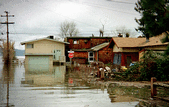El Niño and Probability
| Prashant Sardeshmukh, Gilbert Compo, and Cécile Penland NOAA/ESRL Physical Sciences Laboratory Science Writer: Susan Bacon University of Colorado |

|
ENSO ImpactsENSO causes some of the most significant, yet predictable, shifts in global weather. Its impacts are easiest to see in tropical areas, but it can also affect weather outside of the tropics. For instance, an El Niño winter, in which sea surface temperatures are higher than normal in the east central Pacific, brings cooler and wetter weather to the Southern United States, and warmer and drier weather to the Pacific Northwest. A La Niña winter in the east central Pacific, on the other hand, has lower than normal sea surface temperatures and causes nearly opposite weather patterns. Describing ENSO impacts on weather not only provides better information on how the climate system works in general, but it also gives researchers clues about the likelihood that extreme weather events - from floods and droughts, to blizzards and heat waves - will take place in areas outside of the tropics. This advance warning helps people prepare, and so reduces the loss of lives and other damage extreme weather can cause. Researchers know there is a connection between ENSO and weather outside of the tropics, but remain challenged when forecasting how a specific ENSO event will affect weather in these areas. One reason that forecasts are difficult is that ENSO's impact on weather outside of the tropics is small, and so is almost obscured by the climate's natural variability in these areas. That's why a large sample size is important: Only with enough data points can researchers distinguish natural variability from the outside influence. |

|
Figure 1. Probability density functions (PDFs) in the left panel illustrate the impact of changes in the mean on the probability of extreme values (left panel). PDFs in the right panel illustrates impact of changes in both the mean and the spread on the probability of extreme values. Green (orange) shading indicates an increase (decrease) of the probability of extreme values. |
Distinguishing ENSO from natural variability is helpful because even if ENSO has small effects on average weather patterns, it may still cause significant changes inthe overall distribution. For example, even a slight change in the average weather pattern in response to ENSO can alter the likelihoods of extreme weather events, such as droughts, floods and storms. This idea is illustrated by Figure 1, where a small shift in the bell curve results in a significant change in the probability of having an extreme value. In the bell curve with the shift, there is no longer an equal chance of having an extreme positive value or an extreme negative value - rather, in this new bell curve it is four times more likely to have an extreme positive than an extreme negative. If the shifts illustrated in the graphs represented ENSO's effect on rainfall in an area, both the right and left panels would suggest that the area would be much more likely to be flooded with heavy rains than to suffer through a drought.
| Next |